Evaluating Organisation Culture and its Impact at Marks and Spencer
VerifiedAdded on 2023/06/18
|12
|3521
|386
Report
AI Summary
This report provides an analysis of organisation behaviour at Marks and Spencer, utilizing secondary research to explore the company's culture. It employs Handy's cultural model and Maslow's theory to understand employee motivation. The report investigates how Marks and Spencer's culture influences organisational effectiveness, focusing on communication strategies and employee relations. It evaluates the role of culture in motivating employees and suggests ways the company can further enhance its success by leveraging its organisational culture, including fostering positive employee relations and effective communication strategies, while also considering the 7C's of communication to improve the workplace environment.
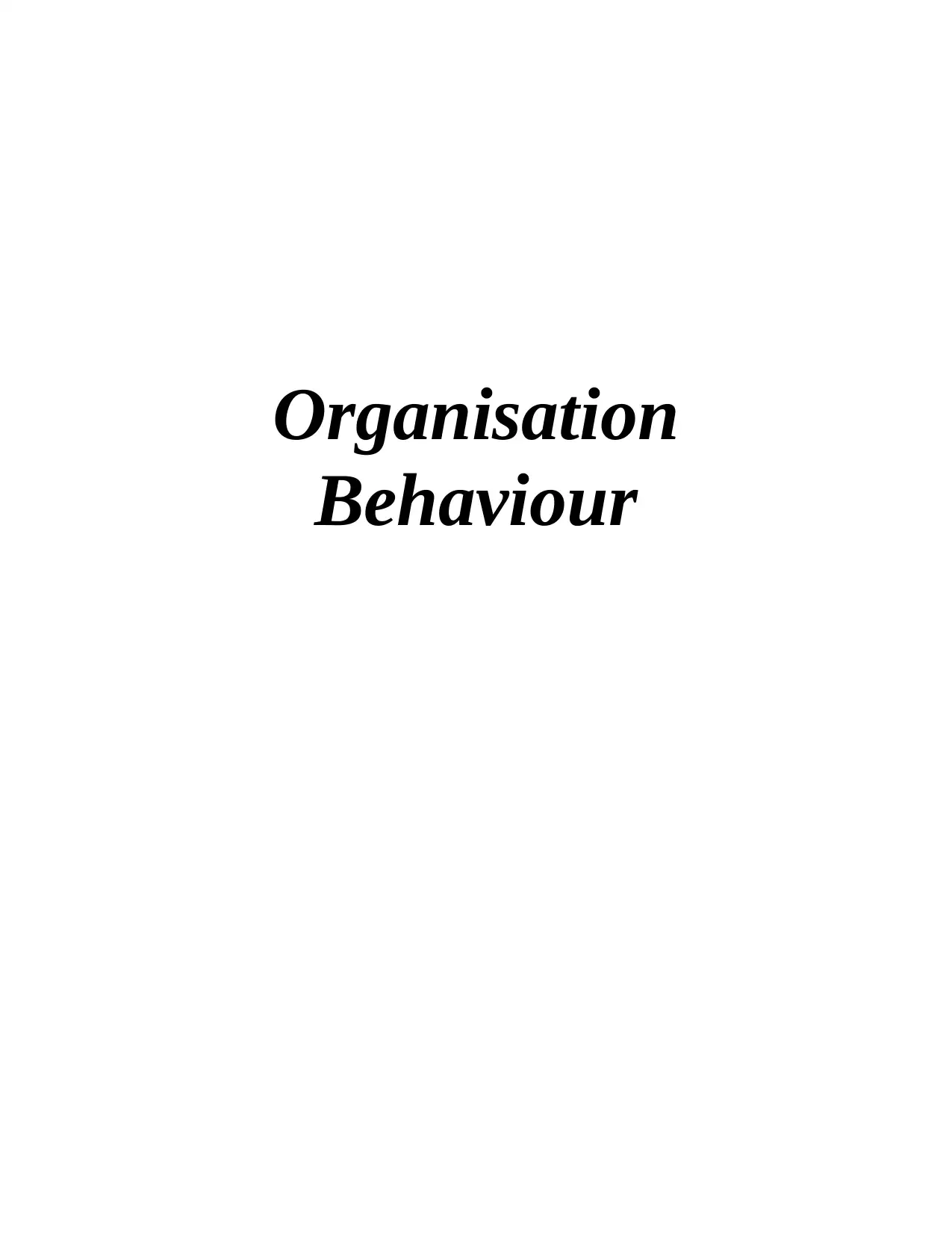
Organisation
Behaviour
Behaviour
Paraphrase This Document
Need a fresh take? Get an instant paraphrase of this document with our AI Paraphraser
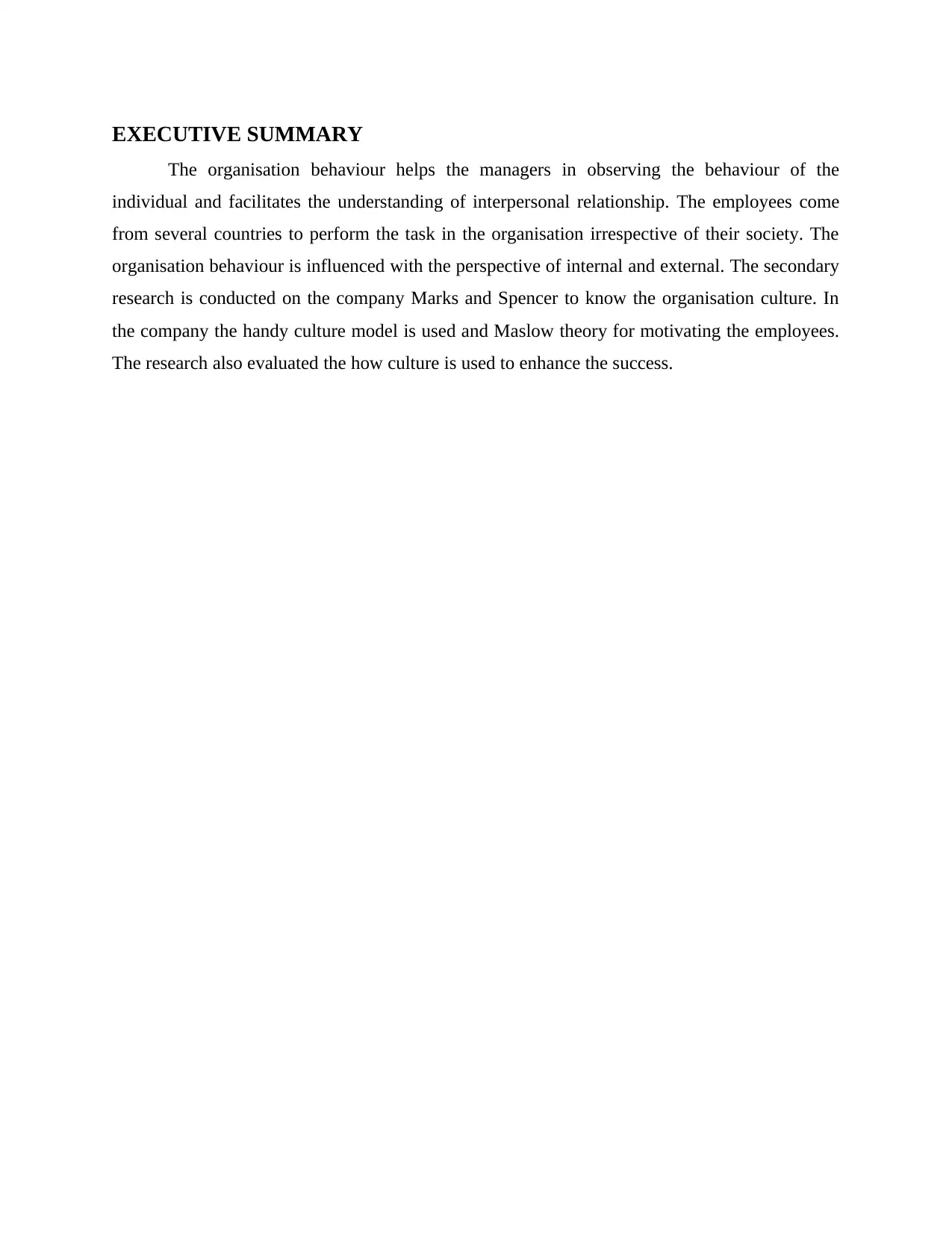
EXECUTIVE SUMMARY
The organisation behaviour helps the managers in observing the behaviour of the
individual and facilitates the understanding of interpersonal relationship. The employees come
from several countries to perform the task in the organisation irrespective of their society. The
organisation behaviour is influenced with the perspective of internal and external. The secondary
research is conducted on the company Marks and Spencer to know the organisation culture. In
the company the handy culture model is used and Maslow theory for motivating the employees.
The research also evaluated the how culture is used to enhance the success.
The organisation behaviour helps the managers in observing the behaviour of the
individual and facilitates the understanding of interpersonal relationship. The employees come
from several countries to perform the task in the organisation irrespective of their society. The
organisation behaviour is influenced with the perspective of internal and external. The secondary
research is conducted on the company Marks and Spencer to know the organisation culture. In
the company the handy culture model is used and Maslow theory for motivating the employees.
The research also evaluated the how culture is used to enhance the success.
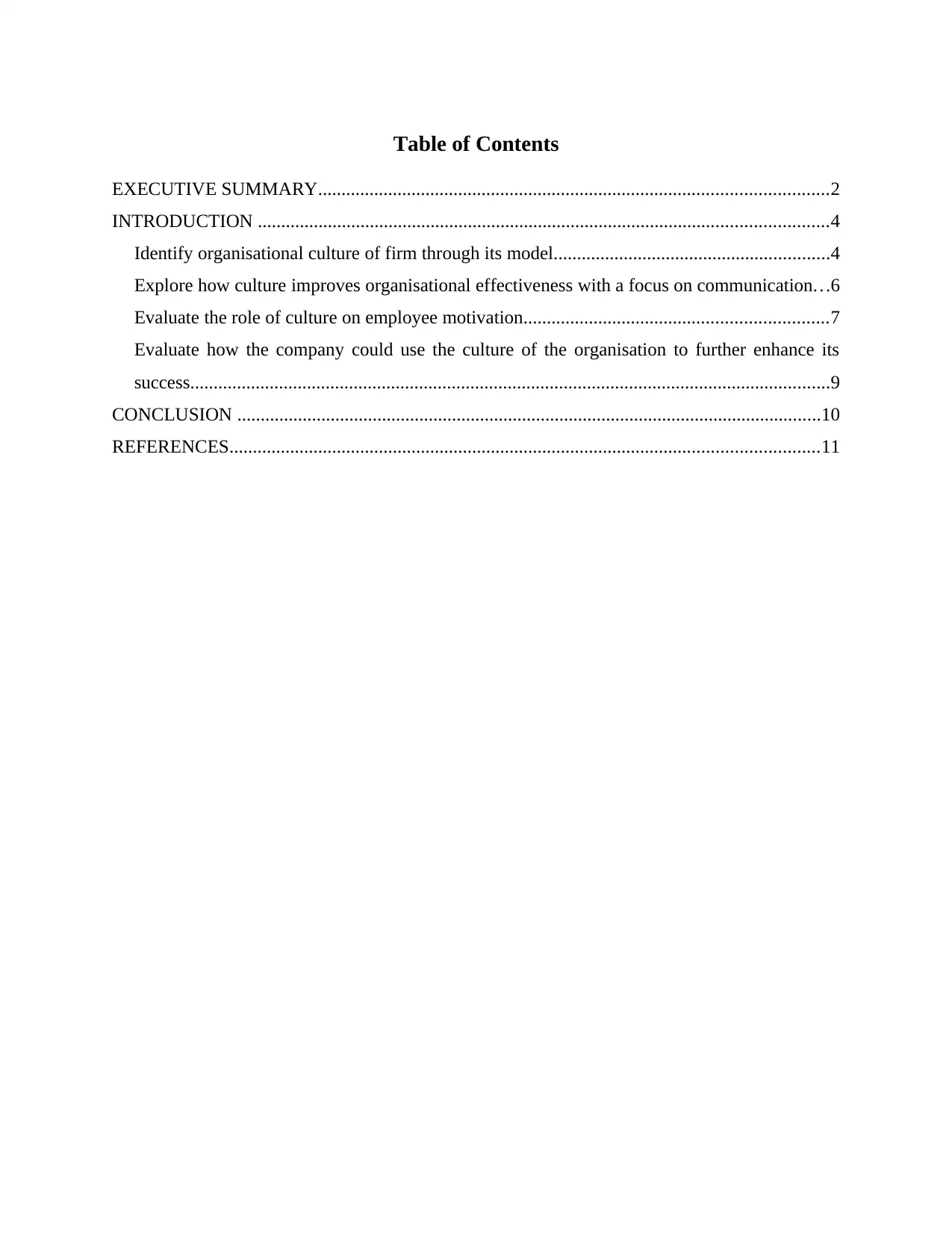
Table of Contents
EXECUTIVE SUMMARY.............................................................................................................2
INTRODUCTION ..........................................................................................................................4
Identify organisational culture of firm through its model...........................................................4
Explore how culture improves organisational effectiveness with a focus on communication...6
Evaluate the role of culture on employee motivation.................................................................7
Evaluate how the company could use the culture of the organisation to further enhance its
success.........................................................................................................................................9
CONCLUSION .............................................................................................................................10
REFERENCES..............................................................................................................................11
EXECUTIVE SUMMARY.............................................................................................................2
INTRODUCTION ..........................................................................................................................4
Identify organisational culture of firm through its model...........................................................4
Explore how culture improves organisational effectiveness with a focus on communication...6
Evaluate the role of culture on employee motivation.................................................................7
Evaluate how the company could use the culture of the organisation to further enhance its
success.........................................................................................................................................9
CONCLUSION .............................................................................................................................10
REFERENCES..............................................................................................................................11
⊘ This is a preview!⊘
Do you want full access?
Subscribe today to unlock all pages.

Trusted by 1+ million students worldwide
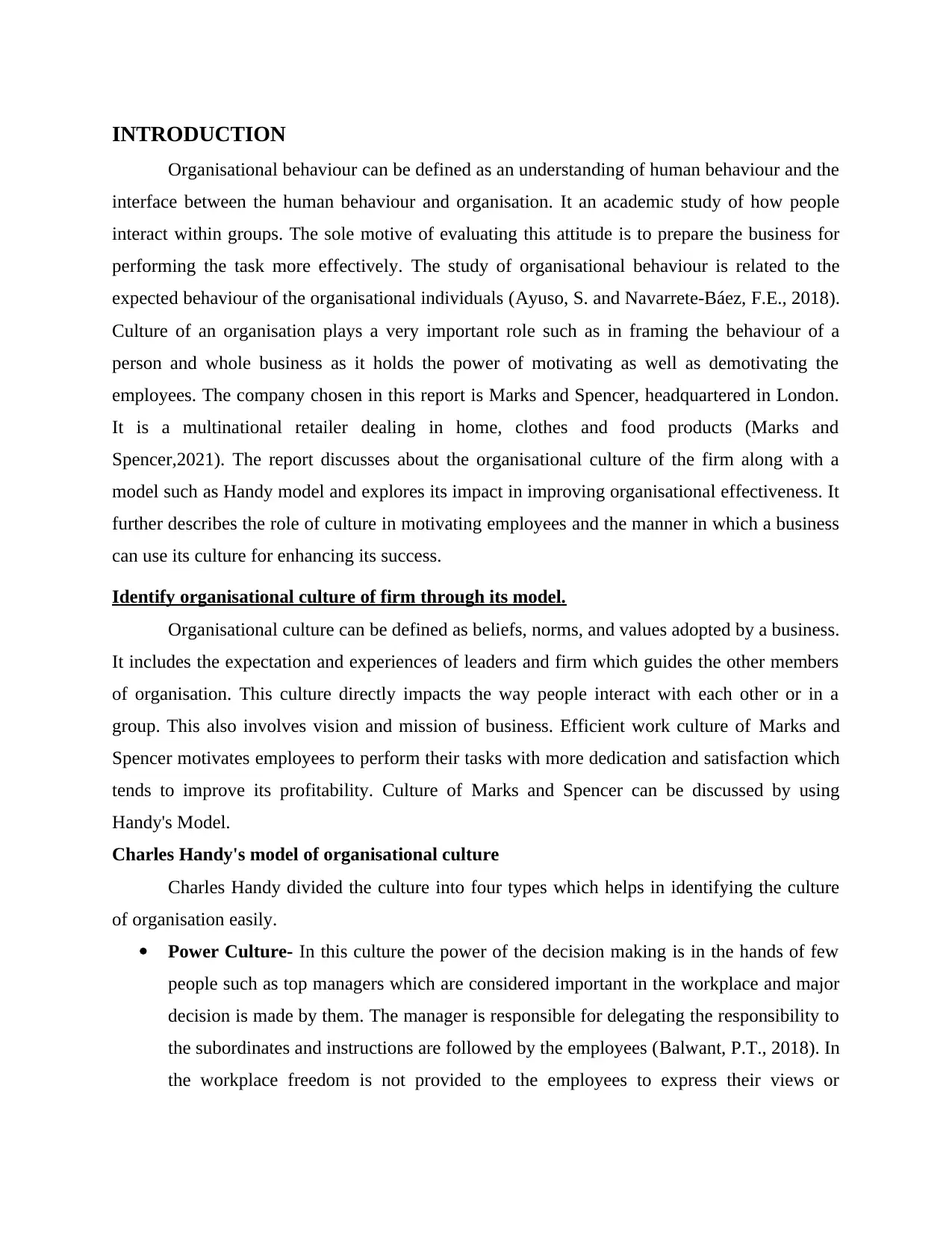
INTRODUCTION
Organisational behaviour can be defined as an understanding of human behaviour and the
interface between the human behaviour and organisation. It an academic study of how people
interact within groups. The sole motive of evaluating this attitude is to prepare the business for
performing the task more effectively. The study of organisational behaviour is related to the
expected behaviour of the organisational individuals (Ayuso, S. and Navarrete‐Báez, F.E., 2018).
Culture of an organisation plays a very important role such as in framing the behaviour of a
person and whole business as it holds the power of motivating as well as demotivating the
employees. The company chosen in this report is Marks and Spencer, headquartered in London.
It is a multinational retailer dealing in home, clothes and food products (Marks and
Spencer,2021). The report discusses about the organisational culture of the firm along with a
model such as Handy model and explores its impact in improving organisational effectiveness. It
further describes the role of culture in motivating employees and the manner in which a business
can use its culture for enhancing its success.
Identify organisational culture of firm through its model.
Organisational culture can be defined as beliefs, norms, and values adopted by a business.
It includes the expectation and experiences of leaders and firm which guides the other members
of organisation. This culture directly impacts the way people interact with each other or in a
group. This also involves vision and mission of business. Efficient work culture of Marks and
Spencer motivates employees to perform their tasks with more dedication and satisfaction which
tends to improve its profitability. Culture of Marks and Spencer can be discussed by using
Handy's Model.
Charles Handy's model of organisational culture
Charles Handy divided the culture into four types which helps in identifying the culture
of organisation easily.
Power Culture- In this culture the power of the decision making is in the hands of few
people such as top managers which are considered important in the workplace and major
decision is made by them. The manager is responsible for delegating the responsibility to
the subordinates and instructions are followed by the employees (Balwant, P.T., 2018). In
the workplace freedom is not provided to the employees to express their views or
Organisational behaviour can be defined as an understanding of human behaviour and the
interface between the human behaviour and organisation. It an academic study of how people
interact within groups. The sole motive of evaluating this attitude is to prepare the business for
performing the task more effectively. The study of organisational behaviour is related to the
expected behaviour of the organisational individuals (Ayuso, S. and Navarrete‐Báez, F.E., 2018).
Culture of an organisation plays a very important role such as in framing the behaviour of a
person and whole business as it holds the power of motivating as well as demotivating the
employees. The company chosen in this report is Marks and Spencer, headquartered in London.
It is a multinational retailer dealing in home, clothes and food products (Marks and
Spencer,2021). The report discusses about the organisational culture of the firm along with a
model such as Handy model and explores its impact in improving organisational effectiveness. It
further describes the role of culture in motivating employees and the manner in which a business
can use its culture for enhancing its success.
Identify organisational culture of firm through its model.
Organisational culture can be defined as beliefs, norms, and values adopted by a business.
It includes the expectation and experiences of leaders and firm which guides the other members
of organisation. This culture directly impacts the way people interact with each other or in a
group. This also involves vision and mission of business. Efficient work culture of Marks and
Spencer motivates employees to perform their tasks with more dedication and satisfaction which
tends to improve its profitability. Culture of Marks and Spencer can be discussed by using
Handy's Model.
Charles Handy's model of organisational culture
Charles Handy divided the culture into four types which helps in identifying the culture
of organisation easily.
Power Culture- In this culture the power of the decision making is in the hands of few
people such as top managers which are considered important in the workplace and major
decision is made by them. The manager is responsible for delegating the responsibility to
the subordinates and instructions are followed by the employees (Balwant, P.T., 2018). In
the workplace freedom is not provided to the employees to express their views or
Paraphrase This Document
Need a fresh take? Get an instant paraphrase of this document with our AI Paraphraser
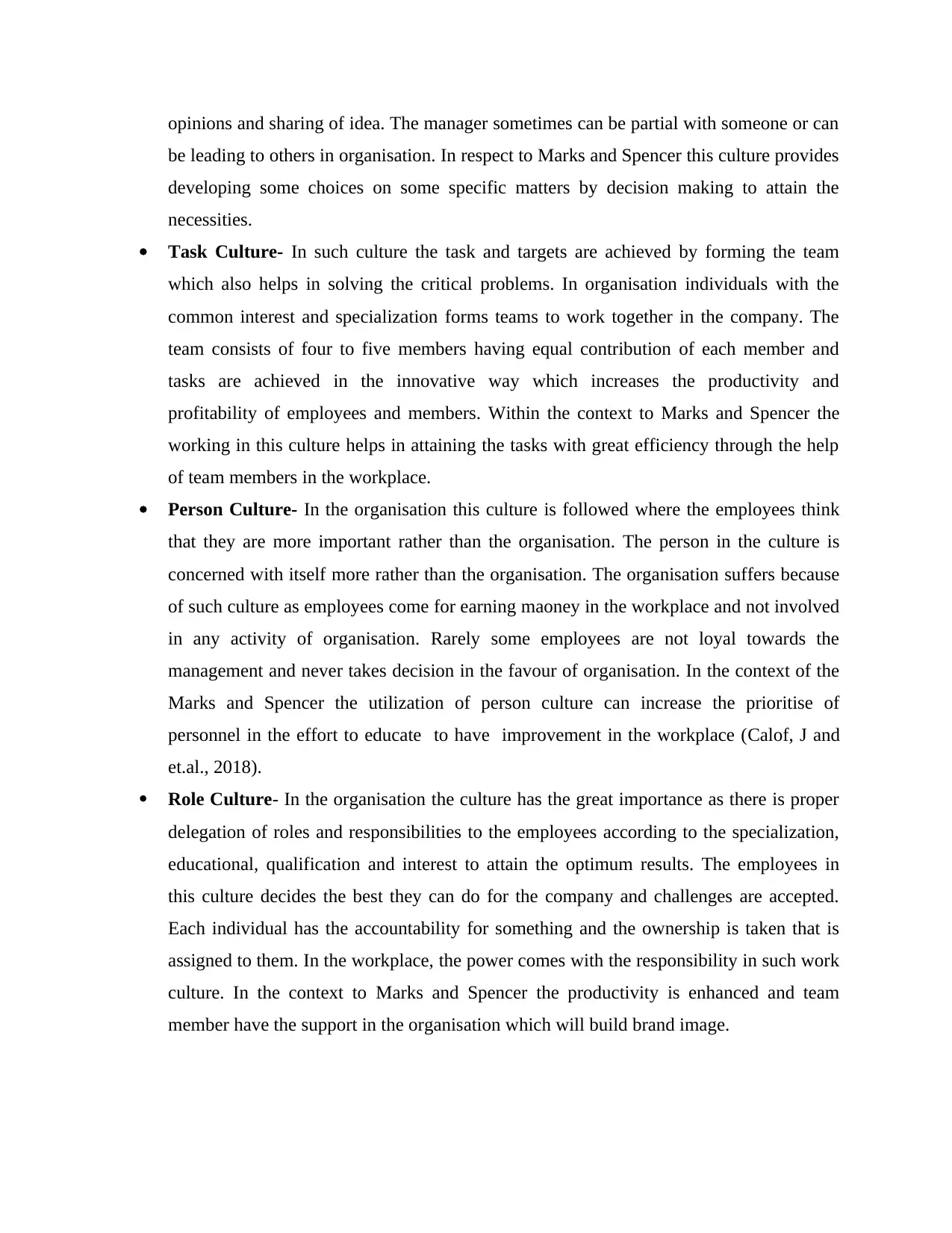
opinions and sharing of idea. The manager sometimes can be partial with someone or can
be leading to others in organisation. In respect to Marks and Spencer this culture provides
developing some choices on some specific matters by decision making to attain the
necessities.
Task Culture- In such culture the task and targets are achieved by forming the team
which also helps in solving the critical problems. In organisation individuals with the
common interest and specialization forms teams to work together in the company. The
team consists of four to five members having equal contribution of each member and
tasks are achieved in the innovative way which increases the productivity and
profitability of employees and members. Within the context to Marks and Spencer the
working in this culture helps in attaining the tasks with great efficiency through the help
of team members in the workplace.
Person Culture- In the organisation this culture is followed where the employees think
that they are more important rather than the organisation. The person in the culture is
concerned with itself more rather than the organisation. The organisation suffers because
of such culture as employees come for earning maoney in the workplace and not involved
in any activity of organisation. Rarely some employees are not loyal towards the
management and never takes decision in the favour of organisation. In the context of the
Marks and Spencer the utilization of person culture can increase the prioritise of
personnel in the effort to educate to have improvement in the workplace (Calof, J and
et.al., 2018).
Role Culture- In the organisation the culture has the great importance as there is proper
delegation of roles and responsibilities to the employees according to the specialization,
educational, qualification and interest to attain the optimum results. The employees in
this culture decides the best they can do for the company and challenges are accepted.
Each individual has the accountability for something and the ownership is taken that is
assigned to them. In the workplace, the power comes with the responsibility in such work
culture. In the context to Marks and Spencer the productivity is enhanced and team
member have the support in the organisation which will build brand image.
be leading to others in organisation. In respect to Marks and Spencer this culture provides
developing some choices on some specific matters by decision making to attain the
necessities.
Task Culture- In such culture the task and targets are achieved by forming the team
which also helps in solving the critical problems. In organisation individuals with the
common interest and specialization forms teams to work together in the company. The
team consists of four to five members having equal contribution of each member and
tasks are achieved in the innovative way which increases the productivity and
profitability of employees and members. Within the context to Marks and Spencer the
working in this culture helps in attaining the tasks with great efficiency through the help
of team members in the workplace.
Person Culture- In the organisation this culture is followed where the employees think
that they are more important rather than the organisation. The person in the culture is
concerned with itself more rather than the organisation. The organisation suffers because
of such culture as employees come for earning maoney in the workplace and not involved
in any activity of organisation. Rarely some employees are not loyal towards the
management and never takes decision in the favour of organisation. In the context of the
Marks and Spencer the utilization of person culture can increase the prioritise of
personnel in the effort to educate to have improvement in the workplace (Calof, J and
et.al., 2018).
Role Culture- In the organisation the culture has the great importance as there is proper
delegation of roles and responsibilities to the employees according to the specialization,
educational, qualification and interest to attain the optimum results. The employees in
this culture decides the best they can do for the company and challenges are accepted.
Each individual has the accountability for something and the ownership is taken that is
assigned to them. In the workplace, the power comes with the responsibility in such work
culture. In the context to Marks and Spencer the productivity is enhanced and team
member have the support in the organisation which will build brand image.
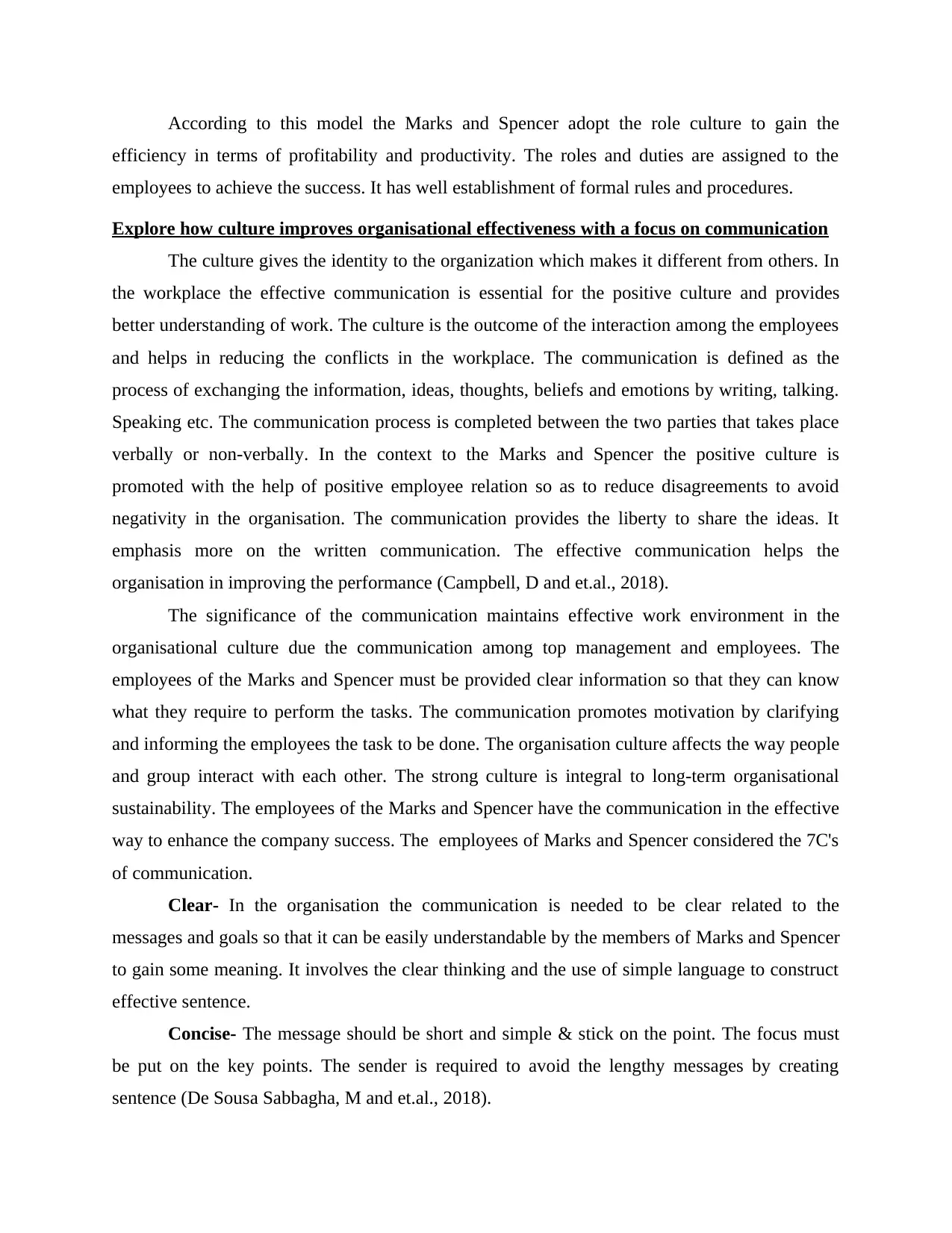
According to this model the Marks and Spencer adopt the role culture to gain the
efficiency in terms of profitability and productivity. The roles and duties are assigned to the
employees to achieve the success. It has well establishment of formal rules and procedures.
Explore how culture improves organisational effectiveness with a focus on communication
The culture gives the identity to the organization which makes it different from others. In
the workplace the effective communication is essential for the positive culture and provides
better understanding of work. The culture is the outcome of the interaction among the employees
and helps in reducing the conflicts in the workplace. The communication is defined as the
process of exchanging the information, ideas, thoughts, beliefs and emotions by writing, talking.
Speaking etc. The communication process is completed between the two parties that takes place
verbally or non-verbally. In the context to the Marks and Spencer the positive culture is
promoted with the help of positive employee relation so as to reduce disagreements to avoid
negativity in the organisation. The communication provides the liberty to share the ideas. It
emphasis more on the written communication. The effective communication helps the
organisation in improving the performance (Campbell, D and et.al., 2018).
The significance of the communication maintains effective work environment in the
organisational culture due the communication among top management and employees. The
employees of the Marks and Spencer must be provided clear information so that they can know
what they require to perform the tasks. The communication promotes motivation by clarifying
and informing the employees the task to be done. The organisation culture affects the way people
and group interact with each other. The strong culture is integral to long-term organisational
sustainability. The employees of the Marks and Spencer have the communication in the effective
way to enhance the company success. The employees of Marks and Spencer considered the 7C's
of communication.
Clear- In the organisation the communication is needed to be clear related to the
messages and goals so that it can be easily understandable by the members of Marks and Spencer
to gain some meaning. It involves the clear thinking and the use of simple language to construct
effective sentence.
Concise- The message should be short and simple & stick on the point. The focus must
be put on the key points. The sender is required to avoid the lengthy messages by creating
sentence (De Sousa Sabbagha, M and et.al., 2018).
efficiency in terms of profitability and productivity. The roles and duties are assigned to the
employees to achieve the success. It has well establishment of formal rules and procedures.
Explore how culture improves organisational effectiveness with a focus on communication
The culture gives the identity to the organization which makes it different from others. In
the workplace the effective communication is essential for the positive culture and provides
better understanding of work. The culture is the outcome of the interaction among the employees
and helps in reducing the conflicts in the workplace. The communication is defined as the
process of exchanging the information, ideas, thoughts, beliefs and emotions by writing, talking.
Speaking etc. The communication process is completed between the two parties that takes place
verbally or non-verbally. In the context to the Marks and Spencer the positive culture is
promoted with the help of positive employee relation so as to reduce disagreements to avoid
negativity in the organisation. The communication provides the liberty to share the ideas. It
emphasis more on the written communication. The effective communication helps the
organisation in improving the performance (Campbell, D and et.al., 2018).
The significance of the communication maintains effective work environment in the
organisational culture due the communication among top management and employees. The
employees of the Marks and Spencer must be provided clear information so that they can know
what they require to perform the tasks. The communication promotes motivation by clarifying
and informing the employees the task to be done. The organisation culture affects the way people
and group interact with each other. The strong culture is integral to long-term organisational
sustainability. The employees of the Marks and Spencer have the communication in the effective
way to enhance the company success. The employees of Marks and Spencer considered the 7C's
of communication.
Clear- In the organisation the communication is needed to be clear related to the
messages and goals so that it can be easily understandable by the members of Marks and Spencer
to gain some meaning. It involves the clear thinking and the use of simple language to construct
effective sentence.
Concise- The message should be short and simple & stick on the point. The focus must
be put on the key points. The sender is required to avoid the lengthy messages by creating
sentence (De Sousa Sabbagha, M and et.al., 2018).
⊘ This is a preview!⊘
Do you want full access?
Subscribe today to unlock all pages.

Trusted by 1+ million students worldwide
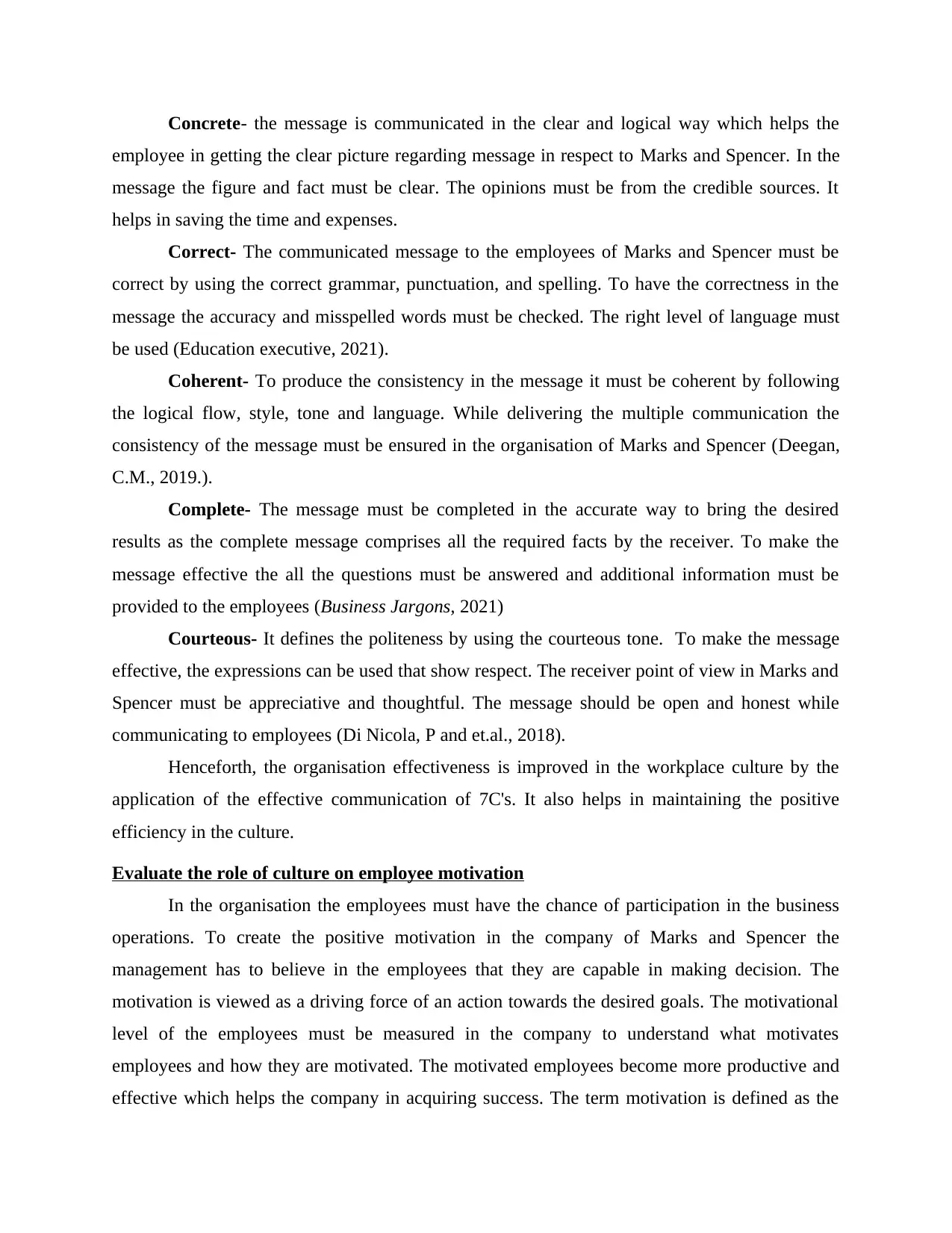
Concrete- the message is communicated in the clear and logical way which helps the
employee in getting the clear picture regarding message in respect to Marks and Spencer. In the
message the figure and fact must be clear. The opinions must be from the credible sources. It
helps in saving the time and expenses.
Correct- The communicated message to the employees of Marks and Spencer must be
correct by using the correct grammar, punctuation, and spelling. To have the correctness in the
message the accuracy and misspelled words must be checked. The right level of language must
be used (Education executive, 2021).
Coherent- To produce the consistency in the message it must be coherent by following
the logical flow, style, tone and language. While delivering the multiple communication the
consistency of the message must be ensured in the organisation of Marks and Spencer (Deegan,
C.M., 2019.).
Complete- The message must be completed in the accurate way to bring the desired
results as the complete message comprises all the required facts by the receiver. To make the
message effective the all the questions must be answered and additional information must be
provided to the employees (Business Jargons, 2021)
Courteous- It defines the politeness by using the courteous tone. To make the message
effective, the expressions can be used that show respect. The receiver point of view in Marks and
Spencer must be appreciative and thoughtful. The message should be open and honest while
communicating to employees (Di Nicola, P and et.al., 2018).
Henceforth, the organisation effectiveness is improved in the workplace culture by the
application of the effective communication of 7C's. It also helps in maintaining the positive
efficiency in the culture.
Evaluate the role of culture on employee motivation
In the organisation the employees must have the chance of participation in the business
operations. To create the positive motivation in the company of Marks and Spencer the
management has to believe in the employees that they are capable in making decision. The
motivation is viewed as a driving force of an action towards the desired goals. The motivational
level of the employees must be measured in the company to understand what motivates
employees and how they are motivated. The motivated employees become more productive and
effective which helps the company in acquiring success. The term motivation is defined as the
employee in getting the clear picture regarding message in respect to Marks and Spencer. In the
message the figure and fact must be clear. The opinions must be from the credible sources. It
helps in saving the time and expenses.
Correct- The communicated message to the employees of Marks and Spencer must be
correct by using the correct grammar, punctuation, and spelling. To have the correctness in the
message the accuracy and misspelled words must be checked. The right level of language must
be used (Education executive, 2021).
Coherent- To produce the consistency in the message it must be coherent by following
the logical flow, style, tone and language. While delivering the multiple communication the
consistency of the message must be ensured in the organisation of Marks and Spencer (Deegan,
C.M., 2019.).
Complete- The message must be completed in the accurate way to bring the desired
results as the complete message comprises all the required facts by the receiver. To make the
message effective the all the questions must be answered and additional information must be
provided to the employees (Business Jargons, 2021)
Courteous- It defines the politeness by using the courteous tone. To make the message
effective, the expressions can be used that show respect. The receiver point of view in Marks and
Spencer must be appreciative and thoughtful. The message should be open and honest while
communicating to employees (Di Nicola, P and et.al., 2018).
Henceforth, the organisation effectiveness is improved in the workplace culture by the
application of the effective communication of 7C's. It also helps in maintaining the positive
efficiency in the culture.
Evaluate the role of culture on employee motivation
In the organisation the employees must have the chance of participation in the business
operations. To create the positive motivation in the company of Marks and Spencer the
management has to believe in the employees that they are capable in making decision. The
motivation is viewed as a driving force of an action towards the desired goals. The motivational
level of the employees must be measured in the company to understand what motivates
employees and how they are motivated. The motivated employees become more productive and
effective which helps the company in acquiring success. The term motivation is defined as the
Paraphrase This Document
Need a fresh take? Get an instant paraphrase of this document with our AI Paraphraser
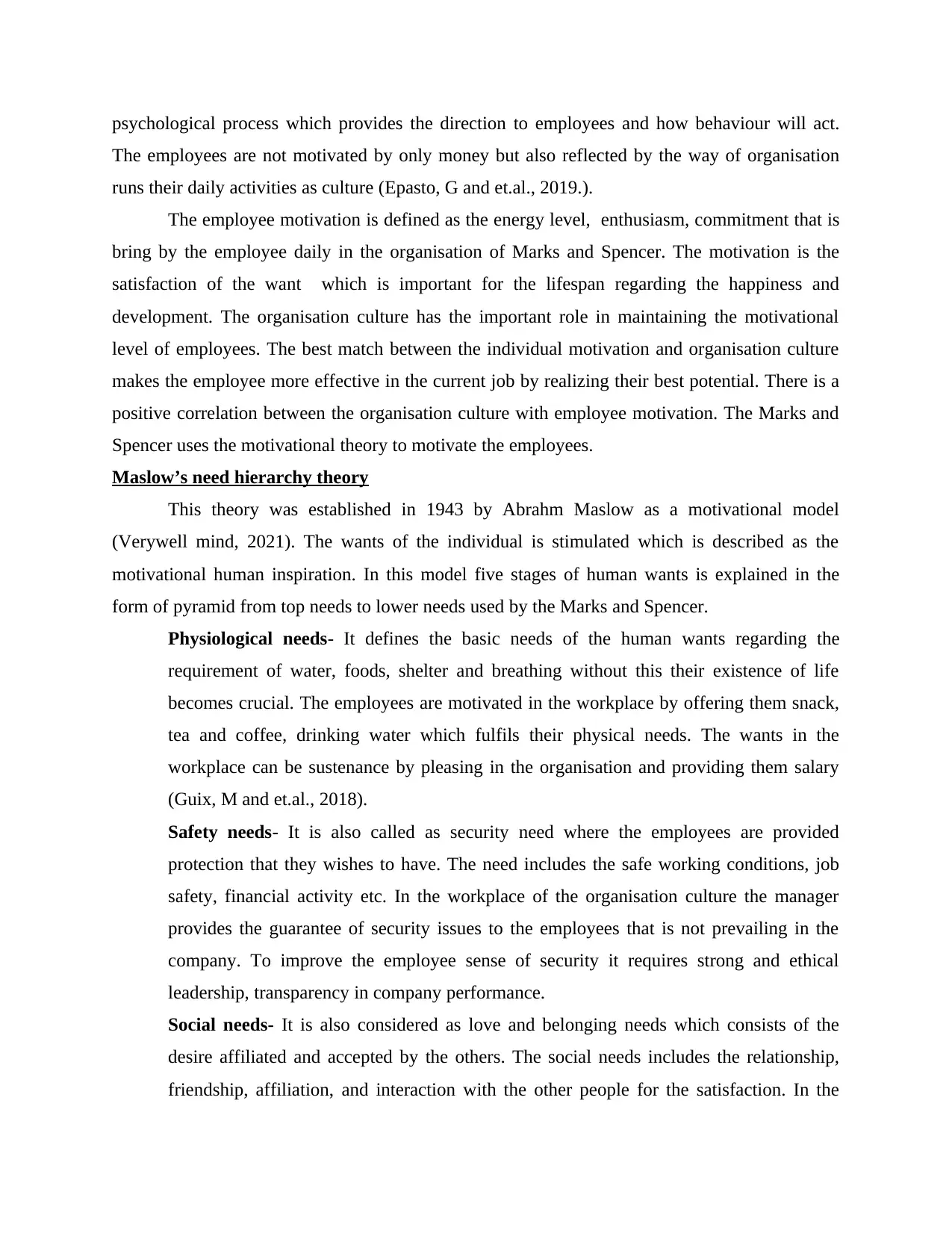
psychological process which provides the direction to employees and how behaviour will act.
The employees are not motivated by only money but also reflected by the way of organisation
runs their daily activities as culture (Epasto, G and et.al., 2019.).
The employee motivation is defined as the energy level, enthusiasm, commitment that is
bring by the employee daily in the organisation of Marks and Spencer. The motivation is the
satisfaction of the want which is important for the lifespan regarding the happiness and
development. The organisation culture has the important role in maintaining the motivational
level of employees. The best match between the individual motivation and organisation culture
makes the employee more effective in the current job by realizing their best potential. There is a
positive correlation between the organisation culture with employee motivation. The Marks and
Spencer uses the motivational theory to motivate the employees.
Maslow’s need hierarchy theory
This theory was established in 1943 by Abrahm Maslow as a motivational model
(Verywell mind, 2021). The wants of the individual is stimulated which is described as the
motivational human inspiration. In this model five stages of human wants is explained in the
form of pyramid from top needs to lower needs used by the Marks and Spencer.
Physiological needs- It defines the basic needs of the human wants regarding the
requirement of water, foods, shelter and breathing without this their existence of life
becomes crucial. The employees are motivated in the workplace by offering them snack,
tea and coffee, drinking water which fulfils their physical needs. The wants in the
workplace can be sustenance by pleasing in the organisation and providing them salary
(Guix, M and et.al., 2018).
Safety needs- It is also called as security need where the employees are provided
protection that they wishes to have. The need includes the safe working conditions, job
safety, financial activity etc. In the workplace of the organisation culture the manager
provides the guarantee of security issues to the employees that is not prevailing in the
company. To improve the employee sense of security it requires strong and ethical
leadership, transparency in company performance.
Social needs- It is also considered as love and belonging needs which consists of the
desire affiliated and accepted by the others. The social needs includes the relationship,
friendship, affiliation, and interaction with the other people for the satisfaction. In the
The employees are not motivated by only money but also reflected by the way of organisation
runs their daily activities as culture (Epasto, G and et.al., 2019.).
The employee motivation is defined as the energy level, enthusiasm, commitment that is
bring by the employee daily in the organisation of Marks and Spencer. The motivation is the
satisfaction of the want which is important for the lifespan regarding the happiness and
development. The organisation culture has the important role in maintaining the motivational
level of employees. The best match between the individual motivation and organisation culture
makes the employee more effective in the current job by realizing their best potential. There is a
positive correlation between the organisation culture with employee motivation. The Marks and
Spencer uses the motivational theory to motivate the employees.
Maslow’s need hierarchy theory
This theory was established in 1943 by Abrahm Maslow as a motivational model
(Verywell mind, 2021). The wants of the individual is stimulated which is described as the
motivational human inspiration. In this model five stages of human wants is explained in the
form of pyramid from top needs to lower needs used by the Marks and Spencer.
Physiological needs- It defines the basic needs of the human wants regarding the
requirement of water, foods, shelter and breathing without this their existence of life
becomes crucial. The employees are motivated in the workplace by offering them snack,
tea and coffee, drinking water which fulfils their physical needs. The wants in the
workplace can be sustenance by pleasing in the organisation and providing them salary
(Guix, M and et.al., 2018).
Safety needs- It is also called as security need where the employees are provided
protection that they wishes to have. The need includes the safe working conditions, job
safety, financial activity etc. In the workplace of the organisation culture the manager
provides the guarantee of security issues to the employees that is not prevailing in the
company. To improve the employee sense of security it requires strong and ethical
leadership, transparency in company performance.
Social needs- It is also considered as love and belonging needs which consists of the
desire affiliated and accepted by the others. The social needs includes the relationship,
friendship, affiliation, and interaction with the other people for the satisfaction. In the
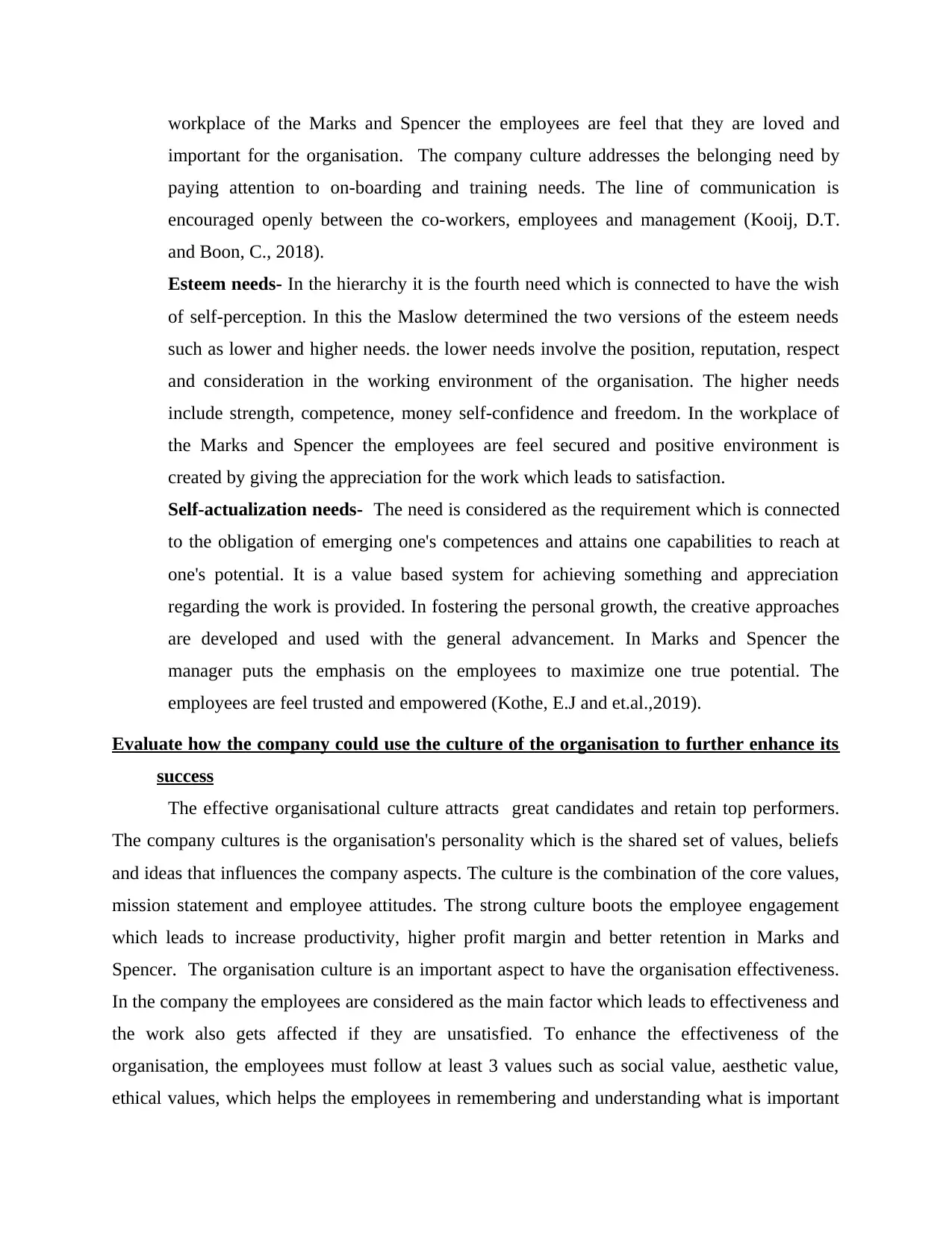
workplace of the Marks and Spencer the employees are feel that they are loved and
important for the organisation. The company culture addresses the belonging need by
paying attention to on-boarding and training needs. The line of communication is
encouraged openly between the co-workers, employees and management (Kooij, D.T.
and Boon, C., 2018).
Esteem needs- In the hierarchy it is the fourth need which is connected to have the wish
of self-perception. In this the Maslow determined the two versions of the esteem needs
such as lower and higher needs. the lower needs involve the position, reputation, respect
and consideration in the working environment of the organisation. The higher needs
include strength, competence, money self-confidence and freedom. In the workplace of
the Marks and Spencer the employees are feel secured and positive environment is
created by giving the appreciation for the work which leads to satisfaction.
Self-actualization needs- The need is considered as the requirement which is connected
to the obligation of emerging one's competences and attains one capabilities to reach at
one's potential. It is a value based system for achieving something and appreciation
regarding the work is provided. In fostering the personal growth, the creative approaches
are developed and used with the general advancement. In Marks and Spencer the
manager puts the emphasis on the employees to maximize one true potential. The
employees are feel trusted and empowered (Kothe, E.J and et.al.,2019).
Evaluate how the company could use the culture of the organisation to further enhance its
success
The effective organisational culture attracts great candidates and retain top performers.
The company cultures is the organisation's personality which is the shared set of values, beliefs
and ideas that influences the company aspects. The culture is the combination of the core values,
mission statement and employee attitudes. The strong culture boots the employee engagement
which leads to increase productivity, higher profit margin and better retention in Marks and
Spencer. The organisation culture is an important aspect to have the organisation effectiveness.
In the company the employees are considered as the main factor which leads to effectiveness and
the work also gets affected if they are unsatisfied. To enhance the effectiveness of the
organisation, the employees must follow at least 3 values such as social value, aesthetic value,
ethical values, which helps the employees in remembering and understanding what is important
important for the organisation. The company culture addresses the belonging need by
paying attention to on-boarding and training needs. The line of communication is
encouraged openly between the co-workers, employees and management (Kooij, D.T.
and Boon, C., 2018).
Esteem needs- In the hierarchy it is the fourth need which is connected to have the wish
of self-perception. In this the Maslow determined the two versions of the esteem needs
such as lower and higher needs. the lower needs involve the position, reputation, respect
and consideration in the working environment of the organisation. The higher needs
include strength, competence, money self-confidence and freedom. In the workplace of
the Marks and Spencer the employees are feel secured and positive environment is
created by giving the appreciation for the work which leads to satisfaction.
Self-actualization needs- The need is considered as the requirement which is connected
to the obligation of emerging one's competences and attains one capabilities to reach at
one's potential. It is a value based system for achieving something and appreciation
regarding the work is provided. In fostering the personal growth, the creative approaches
are developed and used with the general advancement. In Marks and Spencer the
manager puts the emphasis on the employees to maximize one true potential. The
employees are feel trusted and empowered (Kothe, E.J and et.al.,2019).
Evaluate how the company could use the culture of the organisation to further enhance its
success
The effective organisational culture attracts great candidates and retain top performers.
The company cultures is the organisation's personality which is the shared set of values, beliefs
and ideas that influences the company aspects. The culture is the combination of the core values,
mission statement and employee attitudes. The strong culture boots the employee engagement
which leads to increase productivity, higher profit margin and better retention in Marks and
Spencer. The organisation culture is an important aspect to have the organisation effectiveness.
In the company the employees are considered as the main factor which leads to effectiveness and
the work also gets affected if they are unsatisfied. To enhance the effectiveness of the
organisation, the employees must follow at least 3 values such as social value, aesthetic value,
ethical values, which helps the employees in remembering and understanding what is important
⊘ This is a preview!⊘
Do you want full access?
Subscribe today to unlock all pages.

Trusted by 1+ million students worldwide
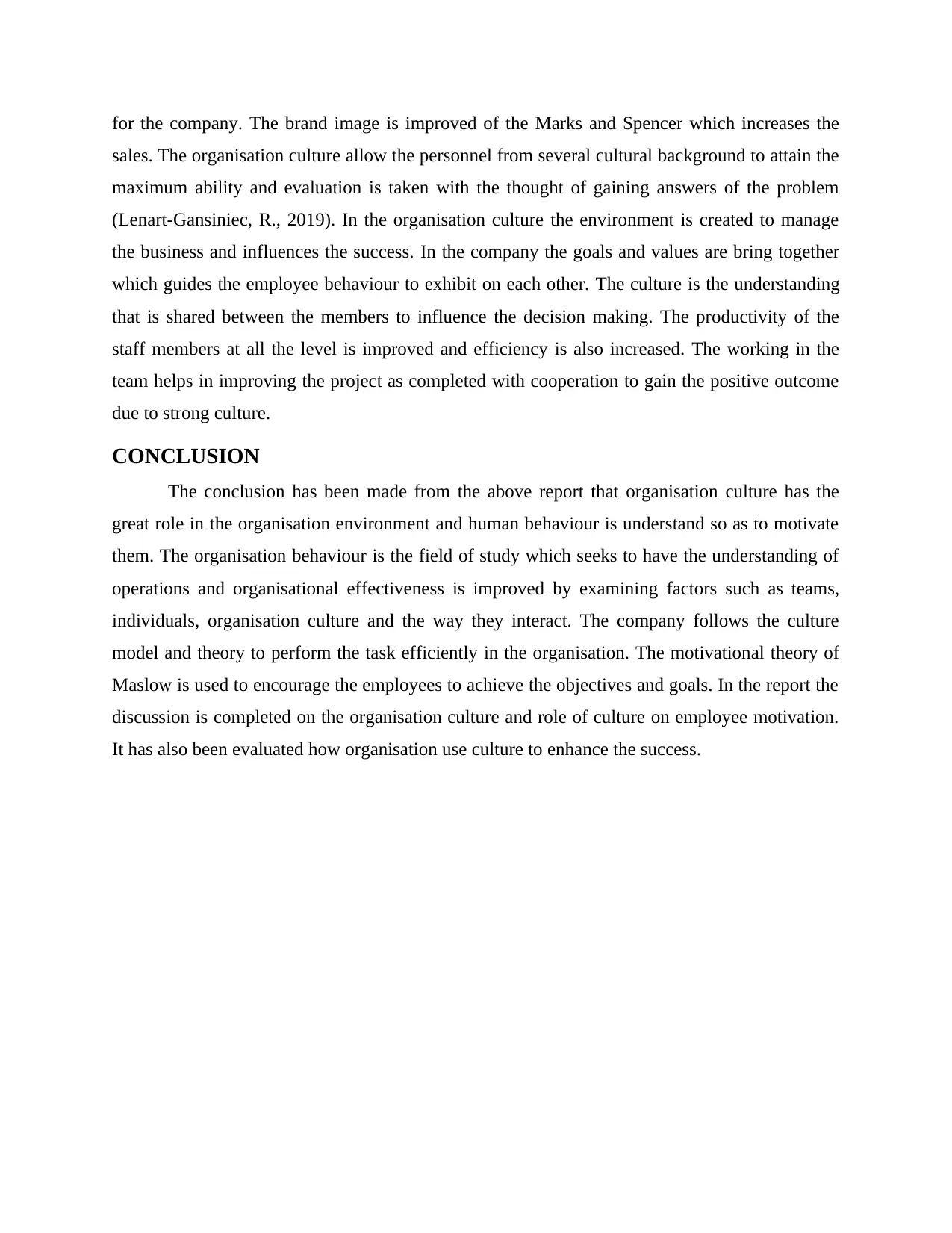
for the company. The brand image is improved of the Marks and Spencer which increases the
sales. The organisation culture allow the personnel from several cultural background to attain the
maximum ability and evaluation is taken with the thought of gaining answers of the problem
(Lenart-Gansiniec, R., 2019). In the organisation culture the environment is created to manage
the business and influences the success. In the company the goals and values are bring together
which guides the employee behaviour to exhibit on each other. The culture is the understanding
that is shared between the members to influence the decision making. The productivity of the
staff members at all the level is improved and efficiency is also increased. The working in the
team helps in improving the project as completed with cooperation to gain the positive outcome
due to strong culture.
CONCLUSION
The conclusion has been made from the above report that organisation culture has the
great role in the organisation environment and human behaviour is understand so as to motivate
them. The organisation behaviour is the field of study which seeks to have the understanding of
operations and organisational effectiveness is improved by examining factors such as teams,
individuals, organisation culture and the way they interact. The company follows the culture
model and theory to perform the task efficiently in the organisation. The motivational theory of
Maslow is used to encourage the employees to achieve the objectives and goals. In the report the
discussion is completed on the organisation culture and role of culture on employee motivation.
It has also been evaluated how organisation use culture to enhance the success.
sales. The organisation culture allow the personnel from several cultural background to attain the
maximum ability and evaluation is taken with the thought of gaining answers of the problem
(Lenart-Gansiniec, R., 2019). In the organisation culture the environment is created to manage
the business and influences the success. In the company the goals and values are bring together
which guides the employee behaviour to exhibit on each other. The culture is the understanding
that is shared between the members to influence the decision making. The productivity of the
staff members at all the level is improved and efficiency is also increased. The working in the
team helps in improving the project as completed with cooperation to gain the positive outcome
due to strong culture.
CONCLUSION
The conclusion has been made from the above report that organisation culture has the
great role in the organisation environment and human behaviour is understand so as to motivate
them. The organisation behaviour is the field of study which seeks to have the understanding of
operations and organisational effectiveness is improved by examining factors such as teams,
individuals, organisation culture and the way they interact. The company follows the culture
model and theory to perform the task efficiently in the organisation. The motivational theory of
Maslow is used to encourage the employees to achieve the objectives and goals. In the report the
discussion is completed on the organisation culture and role of culture on employee motivation.
It has also been evaluated how organisation use culture to enhance the success.
Paraphrase This Document
Need a fresh take? Get an instant paraphrase of this document with our AI Paraphraser
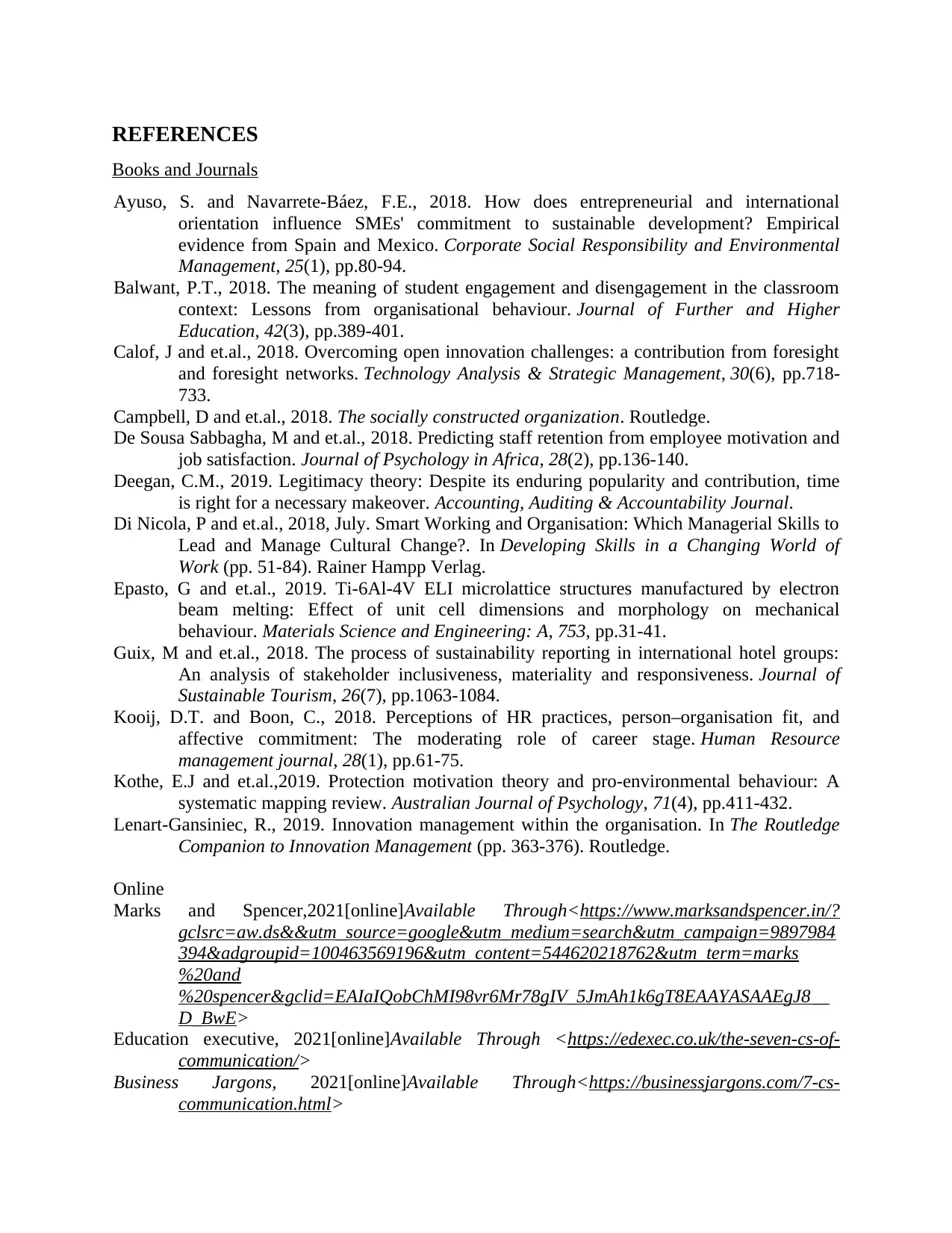
REFERENCES
Books and Journals
Ayuso, S. and Navarrete‐Báez, F.E., 2018. How does entrepreneurial and international
orientation influence SMEs' commitment to sustainable development? Empirical
evidence from Spain and Mexico. Corporate Social Responsibility and Environmental
Management, 25(1), pp.80-94.
Balwant, P.T., 2018. The meaning of student engagement and disengagement in the classroom
context: Lessons from organisational behaviour. Journal of Further and Higher
Education, 42(3), pp.389-401.
Calof, J and et.al., 2018. Overcoming open innovation challenges: a contribution from foresight
and foresight networks. Technology Analysis & Strategic Management, 30(6), pp.718-
733.
Campbell, D and et.al., 2018. The socially constructed organization. Routledge.
De Sousa Sabbagha, M and et.al., 2018. Predicting staff retention from employee motivation and
job satisfaction. Journal of Psychology in Africa, 28(2), pp.136-140.
Deegan, C.M., 2019. Legitimacy theory: Despite its enduring popularity and contribution, time
is right for a necessary makeover. Accounting, Auditing & Accountability Journal.
Di Nicola, P and et.al., 2018, July. Smart Working and Organisation: Which Managerial Skills to
Lead and Manage Cultural Change?. In Developing Skills in a Changing World of
Work (pp. 51-84). Rainer Hampp Verlag.
Epasto, G and et.al., 2019. Ti-6Al-4V ELI microlattice structures manufactured by electron
beam melting: Effect of unit cell dimensions and morphology on mechanical
behaviour. Materials Science and Engineering: A, 753, pp.31-41.
Guix, M and et.al., 2018. The process of sustainability reporting in international hotel groups:
An analysis of stakeholder inclusiveness, materiality and responsiveness. Journal of
Sustainable Tourism, 26(7), pp.1063-1084.
Kooij, D.T. and Boon, C., 2018. Perceptions of HR practices, person–organisation fit, and
affective commitment: The moderating role of career stage. Human Resource
management journal, 28(1), pp.61-75.
Kothe, E.J and et.al.,2019. Protection motivation theory and pro‐environmental behaviour: A
systematic mapping review. Australian Journal of Psychology, 71(4), pp.411-432.
Lenart-Gansiniec, R., 2019. Innovation management within the organisation. In The Routledge
Companion to Innovation Management (pp. 363-376). Routledge.
Online
Marks and Spencer,2021[online]Available Through<https://www.marksandspencer.in/?
gclsrc=aw.ds&&utm_source=google&utm_medium=search&utm_campaign=9897984
394&adgroupid=100463569196&utm_content=544620218762&utm_term=marks
%20and
%20spencer&gclid=EAIaIQobChMI98vr6Mr78gIV_5JmAh1k6gT8EAAYASAAEgJ8__
D_BwE>
Education executive, 2021[online]Available Through <https://edexec.co.uk/the-seven-cs-of-
communication/>
Business Jargons, 2021[online]Available Through<https://businessjargons.com/7-cs-
communication.html>
Books and Journals
Ayuso, S. and Navarrete‐Báez, F.E., 2018. How does entrepreneurial and international
orientation influence SMEs' commitment to sustainable development? Empirical
evidence from Spain and Mexico. Corporate Social Responsibility and Environmental
Management, 25(1), pp.80-94.
Balwant, P.T., 2018. The meaning of student engagement and disengagement in the classroom
context: Lessons from organisational behaviour. Journal of Further and Higher
Education, 42(3), pp.389-401.
Calof, J and et.al., 2018. Overcoming open innovation challenges: a contribution from foresight
and foresight networks. Technology Analysis & Strategic Management, 30(6), pp.718-
733.
Campbell, D and et.al., 2018. The socially constructed organization. Routledge.
De Sousa Sabbagha, M and et.al., 2018. Predicting staff retention from employee motivation and
job satisfaction. Journal of Psychology in Africa, 28(2), pp.136-140.
Deegan, C.M., 2019. Legitimacy theory: Despite its enduring popularity and contribution, time
is right for a necessary makeover. Accounting, Auditing & Accountability Journal.
Di Nicola, P and et.al., 2018, July. Smart Working and Organisation: Which Managerial Skills to
Lead and Manage Cultural Change?. In Developing Skills in a Changing World of
Work (pp. 51-84). Rainer Hampp Verlag.
Epasto, G and et.al., 2019. Ti-6Al-4V ELI microlattice structures manufactured by electron
beam melting: Effect of unit cell dimensions and morphology on mechanical
behaviour. Materials Science and Engineering: A, 753, pp.31-41.
Guix, M and et.al., 2018. The process of sustainability reporting in international hotel groups:
An analysis of stakeholder inclusiveness, materiality and responsiveness. Journal of
Sustainable Tourism, 26(7), pp.1063-1084.
Kooij, D.T. and Boon, C., 2018. Perceptions of HR practices, person–organisation fit, and
affective commitment: The moderating role of career stage. Human Resource
management journal, 28(1), pp.61-75.
Kothe, E.J and et.al.,2019. Protection motivation theory and pro‐environmental behaviour: A
systematic mapping review. Australian Journal of Psychology, 71(4), pp.411-432.
Lenart-Gansiniec, R., 2019. Innovation management within the organisation. In The Routledge
Companion to Innovation Management (pp. 363-376). Routledge.
Online
Marks and Spencer,2021[online]Available Through<https://www.marksandspencer.in/?
gclsrc=aw.ds&&utm_source=google&utm_medium=search&utm_campaign=9897984
394&adgroupid=100463569196&utm_content=544620218762&utm_term=marks
%20and
%20spencer&gclid=EAIaIQobChMI98vr6Mr78gIV_5JmAh1k6gT8EAAYASAAEgJ8__
D_BwE>
Education executive, 2021[online]Available Through <https://edexec.co.uk/the-seven-cs-of-
communication/>
Business Jargons, 2021[online]Available Through<https://businessjargons.com/7-cs-
communication.html>

Verywell mind, 2021[online]Available Through <https://www.verywellmind.com/what-is-
maslows-hierarchy-of-needs-4136760>
maslows-hierarchy-of-needs-4136760>
⊘ This is a preview!⊘
Do you want full access?
Subscribe today to unlock all pages.

Trusted by 1+ million students worldwide
1 out of 12
Related Documents
Your All-in-One AI-Powered Toolkit for Academic Success.
+13062052269
info@desklib.com
Available 24*7 on WhatsApp / Email
![[object Object]](/_next/static/media/star-bottom.7253800d.svg)
Unlock your academic potential
Copyright © 2020–2025 A2Z Services. All Rights Reserved. Developed and managed by ZUCOL.





